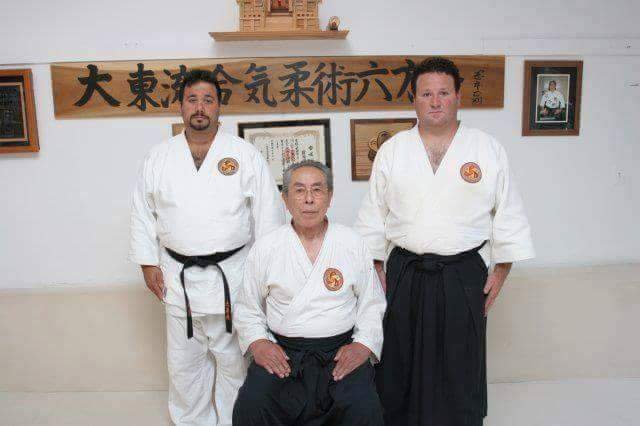
Howard, you and Joe Brogna operate the Daito Ryu Ginjukai in New York. For those who don’t know what it is, please could you tell us about Daito Ryu?
Daitoryu Aikijujutsu was brought to the public eye a few generations ago by Takeda Sokaku. The son of a Samurai, Sokaku was an interesting man who traveled Japan perfecting his craft. In his lifetime, he taught over 30,000 people, mainly important military and police, politicians and prominent businessmen. His most well-known students included Horikawa Kodo, Takuma Hisa, and Ueshiba Morihei who later created Aikido of course. Takeda taught each student based on the time period and the individual characteristics of the student. For example, Hisa Sensei was a powerful person, so he was taught powerful jujutsu. Kodo Sensei was a smaller man, so he was taught movements to help smaller people overcome strength.
How does the Daito Ryu of your lineage differ to other lines? Is there a particular focus in your school of DR?
Our Daito-ryu Aikijujutsu comes from Okamoto Seigo, who was the top student of Horikawa Kodo Sensei. Okamoto’s focus was small, soft techniques that create off balancing on contact. While being a jujutsu master as well, he focused on the movements that break balance. That’s our focus, refining our skills to eventually approach Okamoto’s level.
How would you respond to those who say DRAJ is like a harder, more brutal version of aikido?
Some is, some isn’t. As I said, each of the major students (and Takeda had some 30,000), learned a different version of his budo. Some Daito-ryu is large, powerful, Aikido-like movements, while others are so small and soft that it is barely perceptible, except to the receiver.
How did you get in to martial arts, and what eventually led you to Daito Ryu?
When I was 9 years old, my father wanted me to learn some self-defense. He had taken judo in college, and thought that would be good, but the local dojo was a jujitsu dojo, so he enrolled me there. About 1985, my teacher brought in two Daito-ryu instructors to the dojo. Their movements were incredibly powerful and I liked it. It was many years later in Japan that I realized there were different styles of Daito-ryu, as Okamoto didn’t move anything like those other two men. Again, they were excellent practitioners, just a totally different style and mindset.
Could you tell us about your teacher Okamoto Seigo?
Okamoto Sensei, my teacher, grandfather #3, friend, and mentor. From February 1997, until October 2010 I was in Japan 40 + times, and Okamoto was in my house/dojo about 4 times per year for 5-10 days each time. All he wanted to do was make sure that his Aiki was passed into the next generation. Sensei believed that Japanese children are rarely interested in budo these days, so he wanted to make sure his aiki left Japan. That’s one of the reasons he was in New York so often. The other was our unique relationship. We trained, laughed, drank, ate, fished, and spent family time. Sensei even approved my wife, in Japan, when I got engaged.
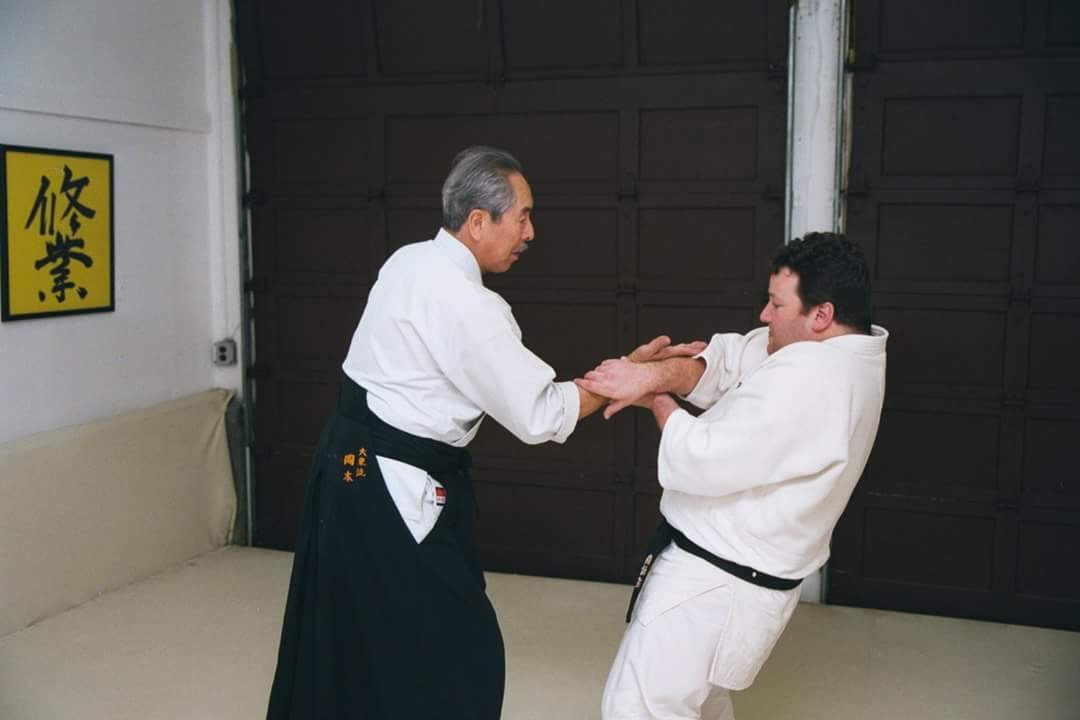
Please tell us more about your visits to Japan to train with Okamoto Sensei?
After meeting Okamoto, I knew I had to try to learn his skills. I became an elementary school teacher because I love kids and it would afford me vacation time to go to Japan. Every minute of free time that was more than 4 or 5 days, I would hop on a plane to Japan. Many of the locals would ask me, “weren’t you just here?” Okamoto Sensei really appreciated my dedication, so he would reward it by teaching me new things.
The visits to Japan were very interesting. They were long, mostly hot, sweaty training days, but after training, Okamoto Sensei would always take a group out eating and drinking. If I was there, I was invited every time (as were many foreigners). Once Sensei had a few drinks, I would always grab him. Much of my education was in an Izakaya in Myogadani Station, in Tokyo.
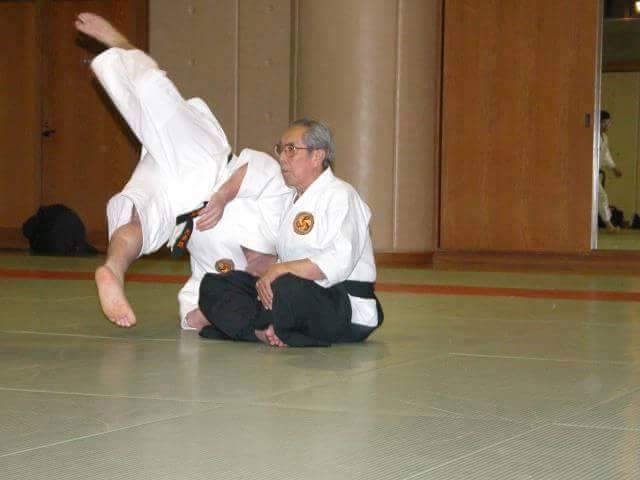
What were Okamoto Sensei’s skills like when he was in his 80s?
Okamoto Sensei continued to improve. Even when I last saw Sensei in 2010, his skills were off the charts. His timing, balance…everything was constantly improving.
What are your thoughts on the Ki/Qi paradigm in Martial Arts?
Ki, Chi, Qi…Okamoto Sensei called it a technique, or combination of techniques. He always gave a very vague, public answer because people always related Ki to wackos. He didn’t want to be associated with that. Also, Sensei was a chemist for Mistubishi, so he had a strong scientific background. If it wasn’t explainable, he wasn’t interested.
Privately was a different story, so I guess you will have to show up to find out.
How would you describe “Aiki”?
Aiki – “the ability to harmonize with the opponent’s energy”.
Unless you have hands on experience with a qualified instructor, that definition won’t matter.
There are a few running around the world right now, each with a slightly different approach, but very qualified in their own way. There are also quite a few Asian masters who have similar skills, but it is difficult to get them to teach.
In June 2015, you visited the UK for the second year running, and tickets to your seminars sold out. How do you like the UK?
The UK is GREAT! I grew up on Monty Python and Fawlty Towers! I love British humour and of course the long relationship with the U.S. More importantly, all the people that I have met in the UK were wonderful to work with! They even got me cold beer 😉
Many of the participants at your seminars were very experienced aikido practitioners. What does Daito Ryu offer them?
Aikido calls itself the art of soft power. The definition of soft is different in Daito-ryu. We don’t call avoiding soft. We don’t call non-concussive soft. Soft, to an experienced Daito-ryu person is – never hit the point of contact, never use force against force, never use hips to generate force, and always try to be very relaxed. Again, you need to grab a qualified person, otherwise the vocabulary is the same, but definitions differ. I don’t mean that soft is ineffective, quite the contrary, it is overwhelmingly effective.
What can you tell us about the importance of the role of uke in Daito-ryu?
As a student, it is crucial to have training partners that aren’t trying to counter every move. Just like in any new art, any senior can stop you from performing the desired move, especially because they know exactly what is going to happen. A firm attack with no extra direction is a good place to start. When you become proficient, then mix it up.
The feedback from your recent UK seminar was very positive, with participants reporting they were blown away by your skills. Many said they couldn’t believe how effortlessly you controlled everyone without exception.
Thanks for the kind words. I am a just a student constantly trying to hone my skills.
What does a student need to develop these skills?
Two things… training time with a qualified instructor who is willing to teach, then putting in the required effort. You can’t see the skills at a seminar and expect to learn them so easily. They require a different way of moving and thinking about yourself and the relationship to others. That only comes through time and proper training. People interested in Daitoryu anywhere in the world need to seek qualified instruction. Unfortunately, that means different things to different people. While Okamoto’s lineage brought me to him initially, it was his warm, welcoming personality, his amazing skills, and his willingness to teach them that enabled us to form a long lasting relationship. While I believe that are other branches of Daito-ryu in the UK, I have no personal experience with them so I couldn’t tell you anything about them. If you are interested in Daito-ryu Ginjukai, please visit www.daitoryu.co.uk. It’s our fledgling UK study group, but it is dedicated to acquiring the Aiki of the Daitoryu Ginjukai. It is my goal to get to the UK at least twice per year to oversee their education and training.
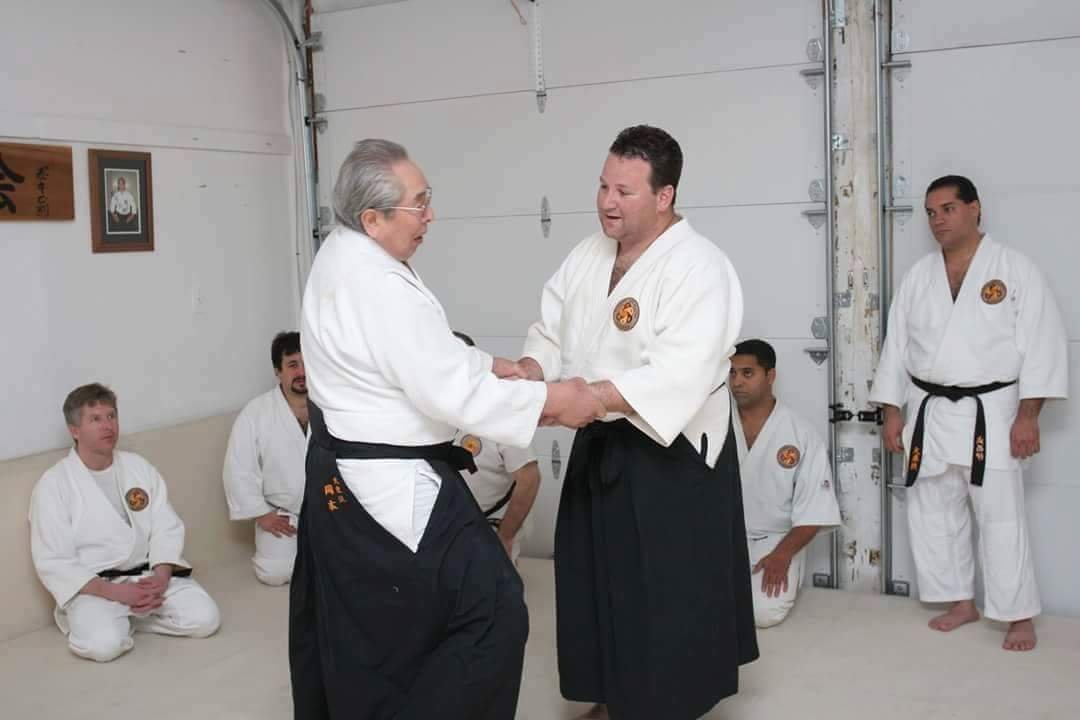
Okamoto Sensei sadly passed away in January of 2015 shortly before his 90th Birthday. Please could you tell us some more about your time as his student.
My experience with Okamoto Sensei began February 10, 1997. It just so happened that February 10, was also Okamoto’s birthday. My first trip there was 10 days. My dad came with me to Japan, and I believe that had a tremendous impact on my relationship with Okamoto. Sensei was looking for someone with particular character traits. Okamoto Sensei told me that anyone in their 20’s who was willing to travel with their parents was the correct kind of person to study with him. For me, it was an honour and a pleasure to have my father there with me.
The first trip to Japan set the tone for my 14 year relationship with Okamoto. When I arrived at the dojo after flying 22 hours (no one told us there was a direct flight from JFK), Okamoto insisted that we have two big Sapporo Beers with him. Once near the actual tatami, I decided to see what skills the old man had. Without warning, I went for the sucker punch. Okamoto proceeded to wave his hand and toss me across the room as easily as someone else would throw out a beer can.
Speaking no Japanese at the time, Okamoto Sensei grabbed a translator and walked over to me and said, “gomen nasai”. I didn’t know what that was, so the translator explained that Sensei was apologizing to me. When I asked, “why?” He explained that Okamoto doesn’t usually walk over to apologize, so I should accept it. I did of course and said, “If it is Okay with Sensei, I’m going to shut up and go get on the end of the line to practice.” He said, “Okamoto Sensei likes that, especially the shutting up part!”. That was the beginning of a beautiful friendship.
For the next ten days, I trained, ate, drank, sweated, and bled Daitoryu with Okamoto. On the 3rd Monday of that month, the dojo was closed for cleaning as it was in a town sports centre. Jokingly, I said to Okamoto that we could practice in my hotel. He said, OK! I rushed back to the Hotel Dai Ichi Inn in Ikebukuro and rented a conference room. For 2.5 hours, myself and another student attacked Okamoto with various punches, kicks, grabs….it didn’t matter. He dispatched us easily, frequently two at a time on the thin carpet that covered the concrete floor in the hotel. I knew something was up when Okamoto Sensei’s wife came too, in full Kimono. She was there to give her impression of me to Okamoto Sensei. The next day, we were on the train together to go to Yokosuka, the military base to train with another Roppokai group that was there. On the train Okamoto presented me with a plaster cast of his hand. I knew that meant he had chosen me to be his personal student.
For the next 14 years, I was in Japan as often as I could be, and I brought Okamoto Sensei to the US at least four times per year, often four for 5-10 days at a time. We would practice every day. The official record was 3, 1.5 hour classes per day, but Okamoto would never let us off the tatami that easily. My mother would make dinner and have to yell(politely of course) at Sensei to get him to come in and eat.
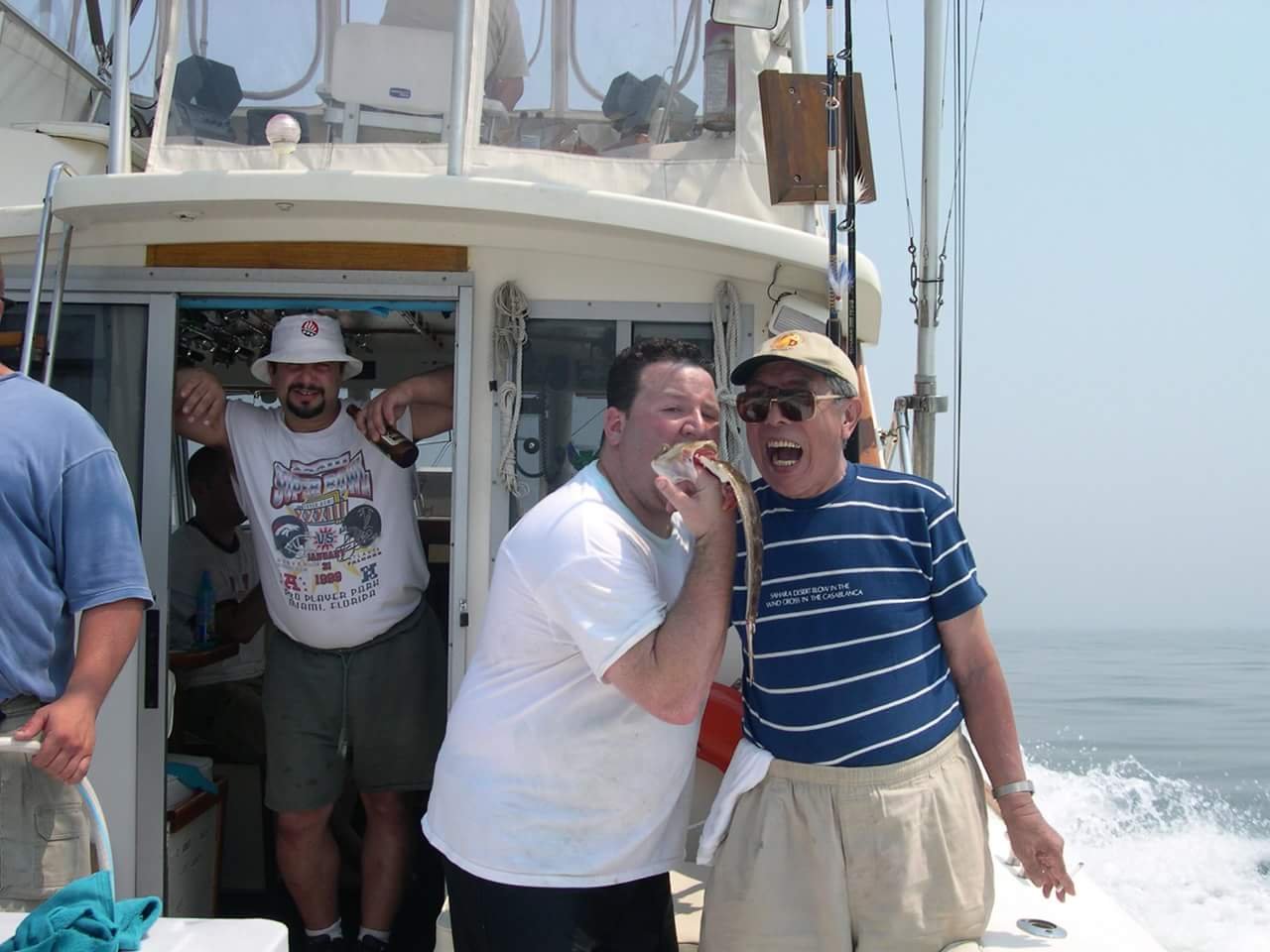
In Japan, Okamoto Sensei would never let me spend any money. He would pay for dinner, drinks, anything that I bought, almost to the point of uncomfortable. Every class he would take a minimum of 6 people out, but often 8-10. He would always pay the bill, usually in the $500-$600 dollar range. One time, I thought I would be cool and sneaked out and paid the bill. When Sensei asked for the check, the waitress told him I paid. With his cool, calm, expressionless face, he said,” Arigato Gozaimasu.” , but then when we left, he proceeded to throw me down the steps at Myogadani Station. That was obviously the last time I paid the bill.
Training in the dojo was always great, whether it was in New York, Tokyo, Copenhagen, California, North Carolina, or anywhere else, but the real training happened in my living room on my couch. After a sake or two, we would grab Okamoto like Kato attacked Peter Sellers in the Pink Panther. We would spend hours analysing his body movements, trying to get the essence of his Aiki. Okamoto was never coy during trips, answering any question I would ask. I miss those days, and I miss Okamoto Seigo Sensei.
